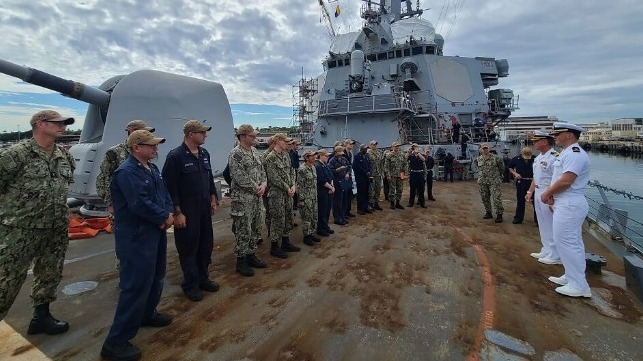U.S. Navy Combs Through Destroyer Fleet for Life-Extension Candidates

The U.S. Navy is high-grading its destroyer fleet by carefully assessing the condition of each ship and selecting only the best hulls for a four- or five-year service life extension and upgrade package. The plan is a retreat from a 2018 proposal to extend the life of every destroyer, and represents a new focus on demonstrating value for money. The example of the cruiser USS Vicksburg - which was nearly finished with a $300 million life extension when the Navy proposed to decommission her - has focused attention on investing limited funds where they will get the most effect.
First-in-class USS Arleigh Burke was the first selected for a five-year service life extension in March, and the upgrades will carry her through until 2031.
Four more ships have now been added to the list: USS Mitscher will serve until 2034, USS Ramage and USS Milius until 2035, and USS Benfold will serve until 2036. The duration of the extensions for Mitscher and Milius is just four years because of their drydocking schedule, which would require a year in drydock to make it to the end of a five-year extension.
All are of the initial Flight I design but have been heavily upgraded over their years in service. Each received improvements to its Aegis combat system during a comprehensive mid-life modernization, which will keep them ready for the high-end fight.
After a close technical review, the Navy determined that the life extensions made sense for these five ships because the vessels kept to their maintenance plans and were well maintained by their crews. The maintenance quality and current condition of the other 16 Flight I DDGs is still under review.
“These service life extensions demonstrate the Navy’s commitment to ensuring the surface fleet has the right capability and capacity,” said Rear Adm. Fred Pyle, director of Surface Warfare. “Adding 23 years of service life cumulatively over the last six months is a significant investment in surface warfare."
The original plan, announced in 2018, was to extend the service life of every destroyer out to 45 years. However, this proposal did not account for wear and tear on individual hulls. The Navy's surface fleet went through a period of overtasking during the 2000s and 2010s, and many of its ships were worked hard. According to Pyle, the new plan is to evaluate the service life of each surface ship based on its relevance in combat, its past reliability and its material condition.
“These DDGs bring the right capability and capacity to our operational commanders in an affordable manner, maximizing the Navy’s targeted return on investment for these ships,” Pyle said.
